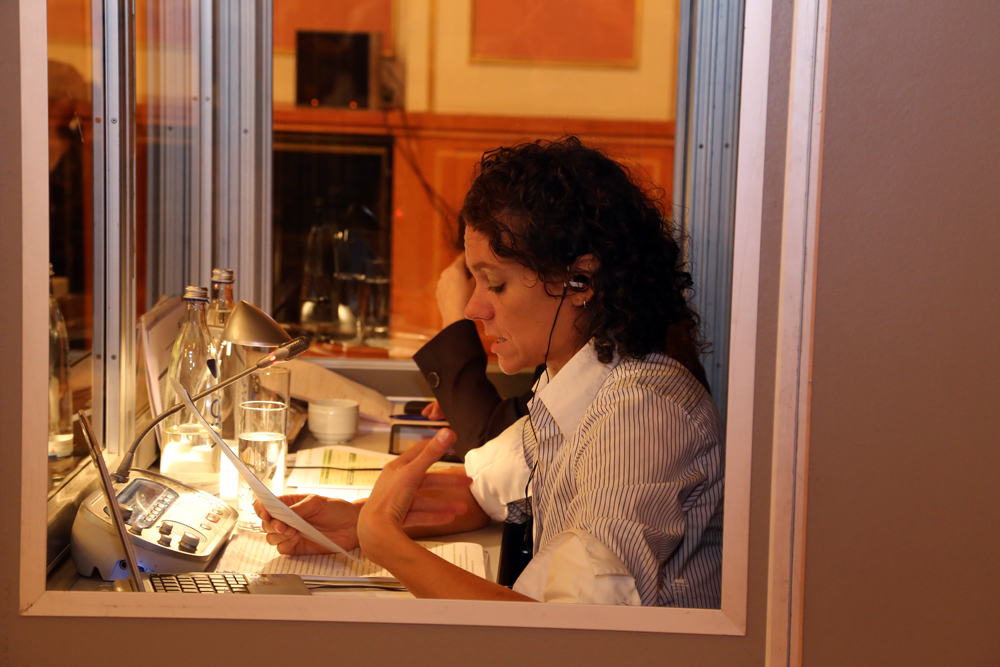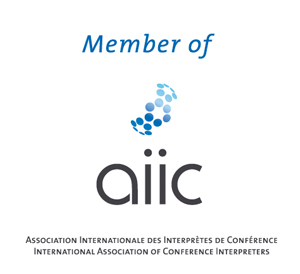
In simultaneous interpreting, the speech is directly conveyed into another language.
The interpreters work in pairs per language and normally take turns every 30 minutes as this type of interpreting requires a very high level of concentration. They work in a soundproof booth, with portable equipment or without technical tools (see whispered interpreting) depending on the number of participants and the language combination.
Consecutive interpreting involves the delayed transmission of speech into another language without the use of technical equipment. Special memory skills are required for this interpreting technique. The interpreter memorises up to 15 minute stretches of a speech using a special note-taking technique and then completely reproduces them in the other language.
It should be noted that the length of the conference doubles with this type of interpreting. It is thus primarily used for conferences with a limited number of participants and is generally limited to two languages.
In ad hoc interpreting, the interpreter conveys in short sections what is said among the few (usually two) interlocutors into the other language in each case. The interpreter can work without technical equipment and note-taking. Ad hoc interpreting is used, for instance, in business negotiations and during trade shows.
Various interpreting techniques are used in court interpreting: simultaneous, consecutive and whispered. The interpreter has to master the languages and various interpreting techniques perfectly and he or she also must have established legal expertise and sound knowledge of the respective cultures. The interpreter has a specific duty of impartiality and is a sworn interpreter or can be sworn-in for the hearing depending on the country.
Whispered interpreting is a type of simultaneous interpreting. The interpreters, however, do not sit in a sound-proof booth but have to work without technical equipment or use portable equipment. In the first instance, the interpreter simultaneously translates what is being said for one to two people. He or she sits close to his or her listeners and whispers the translation into their ears. In the second instance, he or she speaks quietly into a wireless microphone and the listeners can hear the translation in their headsets. Due to background noise, the interpreter is often forced to be close to the speakers. This technique is suitable for events with a limited number of participants and whenever locations have to be changed frequently (e.g. factory tours or visitations).
The interpreters work in pairs per language and normally take turns every 30 minutes as this type of interpreting requires a very high level of concentration. They work in a soundproof booth, with portable equipment or without technical tools (see whispered interpreting) depending on the number of participants and the language combination.
Consecutive interpreting involves the delayed transmission of speech into another language without the use of technical equipment. Special memory skills are required for this interpreting technique. The interpreter memorises up to 15 minute stretches of a speech using a special note-taking technique and then completely reproduces them in the other language.
It should be noted that the length of the conference doubles with this type of interpreting. It is thus primarily used for conferences with a limited number of participants and is generally limited to two languages.
In ad hoc interpreting, the interpreter conveys in short sections what is said among the few (usually two) interlocutors into the other language in each case. The interpreter can work without technical equipment and note-taking. Ad hoc interpreting is used, for instance, in business negotiations and during trade shows.
Various interpreting techniques are used in court interpreting: simultaneous, consecutive and whispered. The interpreter has to master the languages and various interpreting techniques perfectly and he or she also must have established legal expertise and sound knowledge of the respective cultures. The interpreter has a specific duty of impartiality and is a sworn interpreter or can be sworn-in for the hearing depending on the country.
Whispered interpreting is a type of simultaneous interpreting. The interpreters, however, do not sit in a sound-proof booth but have to work without technical equipment or use portable equipment. In the first instance, the interpreter simultaneously translates what is being said for one to two people. He or she sits close to his or her listeners and whispers the translation into their ears. In the second instance, he or she speaks quietly into a wireless microphone and the listeners can hear the translation in their headsets. Due to background noise, the interpreter is often forced to be close to the speakers. This technique is suitable for events with a limited number of participants and whenever locations have to be changed frequently (e.g. factory tours or visitations).




